BPYO - Rehearsal 2 - Recap

Dear BPYO,
We began the second session (October 3rd) by revisiting Cassadó’s performance of Chopin’s Eb Nocturne.
I had sent the link out on his birthday (September 30th) but I couldn’t be sure that everybody had had a chance to listen. I recounted the remarkable story of what happened at the recording session of Mahler 2nd with the Philharmonia in London in 2012.
The second movement of Mahler 2nd is a “Ländler” – a characteristic Austrian country dance that calls for a very special kind of freedom – the kind of rubato playing that would be heard in Viennese coffee houses, but rarely these days from modern symphony orchestras.
Just before we started recording that movement, I took the most unusual step of playing Cassadó’s recording to the orchestra over the loud-speakers.
Here’s how I describe it on the Discussion Disc that accompanies my recording, beginning with a few bars of the movement in an almost metronomic rendition, in order to point out the contrast: Click here
Here is the Philharmonia’s rendition of the 2nd movement on the CD. Click here
(The complete recording of Mahler 2nd is on Spotify)
What actually happened on Saturday was a marvelous mishap: “How Fascinating!”
I had meant for the BPYO players to hear the way that the Philharmonia, had been able to recreate the old-world style after hearing Cassado’s playing, but what my assistant Alonso actually played, by mistake, was BPYO’s performance from their concert in Rotterdam on their 2014 tour to Holland.
I had intended to demonstrate the amazing way that Cassadó’s sound and free manner had inspired the players of one of the world ‘s greatest orchestras, instead we were listening to our youth orchestra!
Here is that performance by the Boston Philharmonic Youth Orchestra, broadcast on European Radio from Rotterdam: Click here
The reason I had decided to go back to the Cassadó was because it represents the most subtle, flexible workings of a musical mind and heart – impossible to fathom, let alone to imitate or conduct. I wanted to have it as an antidote to the work we were doing on 4 bar phrases, which might seem like a dry prescription to play music “by the numbers.”- making the music seem mundane or predictable.
John wrote a beautiful white sheet after hearing the Cassadó.
I’ve had a very hectic week (I have been moving to a new home!), and it constantly felt like things were moving faster than I could handle.
Listening to the recording, I was swept away into a new world. All my troubles and my stresses from school and moving and everything about life didn’t matter; all that mattered was the pulling and pushing of Cassado’s musicality and the way it tugged on my heart. Even with the crackling of the recording, I could still hear the power of his voice through his instrument, and that to me is amazing.
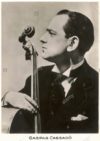
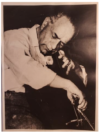
Gaspar Cassadó circa 1927 and in 1954 while I studied with him in Siena and Florence
I am sorry for the way the Chopin cuts off on the Discussion Disc, but here it is uninterrupted.
Just before we listened, I asked everyone to close their eyes and cast their minds back to 1927 – to imagine a different time when the pace of life was different and things were still measured on a human scale –and string players all played with the sweet, warm, clear sound of gut strings. Click here
**************
My plan for the rest of the class was to further explore the shaping of the 4 bar phrase structure and to reveal the forces that undermine it. At the same time, I wanted to address the way in which we underestimate the capacity of children.
Beethoven’s 5th
On each member’s Zoom screen was a copy of my score of Beethoven’s 5th symphony, open at one of the most iconic moments in all of music: the transition between the 3rd movement and the Finale. I asked them to imagine what it must have been like in Vienna on December 22, 1808 when that passage was heard for the first time. Surely nothing could have prepared the audience for what they were going to experience.
Each 4-bar unit in my score is divided by a strong pencil stroke to indicate that Beethoven was thinking of each bar as a beat in a four beat hyper-bar. The timpani taps out a tattoo of the 4 famous notes that start the symphony and then unfolds an astonishing buildup to one of the most majestic climaxes the world had ever heard.
The dynamics in the strings have dropped to ppp for the only time in the symphony (and only one of very few in Beethoven’s entire oeuvre). A shadowy, ghostly figure emerges, as if out of the mist, in the first violins, winding upwards, but without the slightest hint of a crescendo. Any sense of heavy and light beats has disappeared. The enormous energy is suppressed until a few bars before the climax the winds join and a moment later the full power of glorious C major is released. To increase the tension almost to breaking point, Beethoven adds 2 bars to the final 4-bar phrase, – so 11 x 4 plus one “hyper-bar” of 6 beats

N.B. This could be barred differently by having a 6 bar phrase (360-5) before the final 2 4 bar units, which would put the entry of the bassoon and the start of the crescendo on a first beat. But in the absence of heavy and light beats, the listener would not perceive the difference.
The passage begins (at letter C) with a deceptive cadence on Ab. Many years ago I had cheekily penciled in “raise eyebrows”– a reference to my half-humorous suggestion to students to raise their eyebrows whenever they play a deceptive cadence “so that the audience will know”– but that’s exactly what a conductor would do to elicit the softest possible sound with a sense of hushed expectation from the strings.
Before inviting each BPYO member to conduct along with the recording, I pointed out where Beethoven moves down from Ab over F# to G (marked in red) for the dominant preparation to C major. If I had noticed it while we were making the recording, I would have told the bassoons to enter more softly, in order to make the beginning of the crescendo even more amazing, but never mind!
Now the 70+ members of BPYO were almost ready to conduct the passage. All that remained was to point out that what gave the arrival at the C major climax such power was that for that moment Beethoven introduced, for the first time in a symphony, 3 trombones.
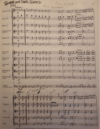
In all the 104 symphonies of Haydn and the 41 of Mozart and the 4 previous ones of Beethoven and for the first three movements of the Fifth, no trombones had been allowed to make a sound, but now, when Beethoven wanted to summon resources of power, triumph and joy unimagined before, he needed those trombones – and a piccolo and a contra bassoon to boot – creating what would be, henceforth, a totally different orchestra! Imagine the stunning impact it must have made on that audience! “Make sure”, I said, “to indicate with your whole body that for that cataclysmic moment you want everybody, and especially those trombones, to raise the roof, for the most significant double bar in the history of the Symphony! But for the entire passage before, keep your body taut and alert, with barely any movement”.
I then asked Alfonso to play that passage from my Philharmonia recording.
I couldn’t see all 70+ members clearly, but in each window on the Zoom screen was a figure staring at an orchestral score, perhaps for the very first time, aware of every part and knowing what to do, as they conducted through one of the most exciting moments in all of music. It is an image I will never forget!
Beethoven’s 5th Finale
So, far so good, but when we arrive at the Finale itself there is a fascinating controversy and that is what we focused on next.
Which is louder, the first bar of the Finale or the second?
I broke off to tell a funny story: “All the beats the same”
One day many decades ago, when I was teaching my Interpretation Class at New England Conservatory, I pointed out that for the second theme of the first movement of Beethoven’s 5th it was difficult to decide if the emphasis (impulse) should come on the first, second, third or fourth bar.

By chance, a member of the class was playing first flute in the NEC orchestra, which was rehearsing the Fifth at that time. I asked her which one had the conductor decided on. She said she would check it out at the next rehearsal. At the following class she reported that the conductor had apparently not made up his mind, because he conducted “all the beats the same”.
“I tried to help”, she reported, “by making strong motions with my head, at first on the first beat and then on the second, then the third and finally, I gave a big nod on the rest before the first bar and then led: “2 3 4 to 1”, but he didn’t seem to notice, or care”
This presents a big problem in musical performance, because if there is no clear direction the listener will quickly tire and then we really are in trouble!
So the question is How Do You Decide?
and
Does it matter?
I told a funny story about the Juilliard Quartet who, according to my dear friend the great Eugene Lehner, who had been their coach, had a nearly catastrophic incident in a performance of Haydn’s Opus 76/1.
The first movement begins with three full chords, after which the cello plays the theme alone:

In a rehearsal a controversy had arisen over whether the impulse (heavy) beat was on bar 3 or 4. Claus Adam, the cellist, favored the first bar of the theme and the three other string players thought the next bar was the heavy one. Since it was three against one, the second bar (i.e. bar 4) won out, and the first cello solo bar would be treated as an upbeat to bar 4 i.e. leading to the F#. The viola, second violin and first violin would then follow suit. However at the concert Claus Adam put his foot down, or rather his heavy-bar down, on bar three, making the B the heavy beat, throwing the other musicians into pandemonium, because they were then forced at a moment’s notice to follow suit. Apparently, when they got off stage an unholy row broke out between them.
That kind of confusion can cause havoc in chamber music rehearsals. I suggested that once musicians agree that the 4 bar-phrase functions exactly the same way as the 4 beat-bar the matter can be settled. Composers in this tradition naturally thought of bars as beats in a larger phrase, with the first bar heavy, the second light, the third heavy, but lighter than the first, and the 4th light.
An Allegro con spirito tempo in 2, as in the Haydn movement, is fast enough that we can easily feel each bar as a beat of a 4-bar phrase, so that the phrase can be tossed off lightly in one sweeping gesture. Try singing it and conduct at the same time, with the impulses on the B and the G, with a light tapering off for the octave D in bar 6.
If you go on YouTube and listen to a few performances of this quartet you will hear that most quartets haven’t fully addressed the problem. The commendable quartet that won the bronze medal in the high school division of the Fishoff Competition is so bogged down in the slurs on each half-bar, at too slow a tempo, that every bar gets the same emphasis, leading to unnecessary dullness. Armed with your new knowledge and the confidence that comes from “throwing yourself into life like a pebble into a pond” any one of you (even the wind and brass players) could now coach them into a wonderfully buoyant rendition of this movement and then watch the ripples!
Now let’s return to the Beethoven 5th Finale: It is incontrovertible that the arrival at the C major and the entry of the largest orchestra ever assembled, MUST be a first (heavy), bar, but what about the second bar? Is that a “light” (or “weak”) bar? Well, yes it is and it underscores the poverty of that terminology, because loud as the first bar is, the second bar is felt to be even louder, because every musician (unless suppressed) feels the intensification of the rising line and the long note on the G. Thereby hangs one of the most fascinating aspects of the classical music language. The “light” second bar gets its energy from the first bar, instead of having the first bar lead to the second bar. Then the next heavy bar is the 3rd bar and the 4th is light.
If you are finding this a bit hard going, think of waking up to this:

The Endurance
So here’s the point: There is a tension or ambiguity between the bar-structure of 4 bars with its recurring heavy and light and the shape of the music. Holding that ambiguity, rather than giving in to simple musical instinct, creates more intensity and excitement in the music, which is then resolved, in this case, with a strong impulse on the 3rd bar.
The powerful natural desire of musicians to lead when the music goes up, and the equally strong desire to lead to a long note, are the two most basic forces that draw musicians, similar to the desire of a dominant chord to LEAD to its resolution tonic. In the Finale of the Fifth, if the musicians are not guided by a conductor, they might either play nothing at all (“all the notes the same”) or they might lead to the second bar and then again to the 4th bar, because, once again, there is the siren’s call of a long note.
In a great performance of the Fifth (and incidentally also of Happy Birthday) where the first emphasis is on BIRTH, and is then drawn to the even more expressive YOU, which is, after all, the purpose of the enterprise!
![]()
The main impulse in the Beethoven is on the first beat (prepared all the way from Letter C) and then it is pulled from that impulse to include and embrace the higher and longer note G, giving us intensity of a different kind on BOTH NOTES!
Unfortunately this cannot be adequately described in words, which is why we get together on Zoom on Saturday afternoons!
Incidentally, I find this struggle between the conflicting elements in music (and the process of unraveling which is which), one of the most thrilling aspects of my life as a musician.
NB Another thing that makes people want to lead is repeated notes. Usually they do lead, but by no means always. More of that on Saturday.
Also sequences always take precedence over heavy and light. Imagine the super tense passage leading to the Finale with alternating heavy and light! The relentless sequence of timpani notes makes that unthinkable. But then imagine the Finale WITHOUT heavy and LIGHT: you’d get mere noise that would turn off every potential music lover.
*********
Beethoven spoke a language – it’s our job to know the grammar. The ambiguity, tension, conflict, that exists between bar-structure and melodic or harmonic shape is our business.
In an orchestra it is the conductor’s job to make the shape of the music clear. However, imagine an orchestra in which every musician feels the shapes and directions the way a conductor does and all of the players feel it the same way. WOW! It’s feasible with a small orchestra (see A FAR CRY), extremely rare with a big orchestra. (But see BPYO).
HENRY
I am planning to introduce different players at our weekly Zoom sessions. If you would like to play, or have a recording of a short piece you would like played, let me know.
I noticed that Henry looked a bit embarrassed while I was telling the story of how he came into BPYO aged 10, but since it is his 7th and (presumably) last year, I felt I could tell it. Also, it is one of the best BPYO stories and I have never told it in print before. So, for the last time, here is the story of Henry. If you know the story move on but it remains remarkable even all these years later.
HENRY’S STORY
I was sitting in my large leather chair at my home at 140 Brattle Street, Cambridge, in 2014, auditioning streams of aspirants to BPYO.
In walked a very small boy. “Henry,” I said looking at his audition form, “it says here you are ten. Are you ten?” “Yep”, he muttered. “We don’t take ten year olds,” I responded. “Can I play?” he said with a mixture of diffidence and defiance. “Sure,” I responded.
Henry lit into the Prelude of Bach’s E major Partita at a breakneck tempo with perfect intonation. I was impressed. Actually, mightily impressed. Then followed Wieniawsky’s 2nd concerto played with a level of authority and emotion that belied his age. His interview was equally impressive. Clearly this was a very unusual kid. When BPYO had been established two years before, Ms. Christensen, Mr. Churchill and I had decided to lower the normal age limit from 14 to 12, and to stretch it upwards to include college-age students up to twenty one. A nine-year age spread is a wide one for any activity – indeed playing in an orchestra may be the only activity in which kids from 12 to 21 can engage effectively together. But we saw an opportunity to offer the older kids a chance to mentor the younger ones and it had worked well the first two years. But a ten-year-old was another matter. Parents were not allowed on tour and the rehearsals were a punishing 4 hours long. How could it possibly work with someone that young?
I went out into the hall to meet his Mom. “He’s extraordinary,” I said, “but I just can’t see taking a ten year old into a touring orchestra of this level.” She replied with one of those deathless phrases that never leave your mind: “What’s he supposed to do, play with other 10 year olds?” “OK”, I said, “we’ll take him!”
Henry did fine. He turned 11 in September and seemed well adjusted to the BPYO experience, though I saw him yawning occasionally towards the end of the long rehearsals. Once I believe he nodded off during a concert on our very exhausting tour.
In April I got a “white sheet” from Emily Chen, who at 16, had been chosen as his most responsible, adult-like stand-partner. “Mr. Zander”, she wrote, “I have a problem. Henry is faking some of the passages, and I don’t know what to do.” I wrote back that this was not her problem and that I would handle it.
I called his teacher and asked if he would give him an extra lesson. His astonishment when I told him the repertoire – Bartok’s Concerto for Orchestra, Daphnis and Chloe, Schoenberg’s Five Pieces, Dvorak’s Cello Concerto – indicated that he had no idea what kind of orchestra his student was involved in, and certainly had not helped him in his lessons.
The following day I got this letter from Henry. Even his eight months in BPYO could not have prepared me for this:
Dear Mr. Zander,
(Actually, though everybody calls me Mr. Zander, Henry wrote: “Dear Ben,”)
Today at a last minute lesson with my teacher, he seemed in a bad mood. I realized that he was nervous because he’d just got off the phone with you. He told me I had to work on my bowing. But before we even began playing, he told me that if I didn’t meet his standards it would reflect him in a bad light. He was being selfish, and he seemed caught up in the downward spiral.
After the lesson, we were in the car, talking about it. I was in the lesson alone, and my mom was waiting in the car. I thought I didn’t want to be in the downward spiral, so we talked about how I don’t have to be discouraged, and I can be a strong person. We decided that if my teacher is caught in the downward spiral I will carry on and be myself, not for reputation, and not out of fear.
My teacher is a good teacher, it’s just that he tends to miss the beauty around him, and he is often faint of heart. Thank you for showing the difference between possibility and negativity, and how to try to give the gift of possibility to everyone I meet, even when things seem discouraging.
I am very exited for this tour, and it will change the way I think about things. The more I see of things in the world, the more I learn to love it.
Sincerely,
Henry
There is an important point about the Henry story that is worth remembering. I had rejected him not because he was not a good enough player, but because he was too young.
How often do we underestimate young people because of our assumptions?
During a crisis meeting with the whole orchestra when three girls broke the curfew rule in Prague, I read out Henry’s letter to the entire orchestra.
I repeated Henry’s words with heavy emphasis: “To give the gift of possibility to everyone I meet, even when things seem discouraging” could be the motto for our tour! “Now who thinks I did the right thing to take Henry into the orchestra?” This was greeted by wild applause from the entire group and, of course, Henry became a star. “I couldn’t have written a letter like that at that age,” remarked a college sophomore. “Come to think of it,” she added after a moment’s pause, “I don’t think I could write a letter like that now.”
And from then on Henry became completely integrated into the group, a favorite of the college kids, playing cards with them and hanging out long into the evening. Another of those false barriers had been broken down.
James Buswell became his teacher and now, seven years later, he is one of the leaders of BPYO and he NEVER fakes any of the notes!
The story of the ten-year old Henry made a nice segue into the next section:
Children Unbound
Do we underestimate children when we settle for child-like playing from children, and even adults, who could do much better? It is not hard to explain the basics of musical grammar to children.
Watch Zubin Mehta’s great grandson at 18 months: Click here.
The slow, laborious progression from the 7 year-old to the 11 year old that I demonstrated in my TED talk could be compressed if we simply explained to a bright child that the first bar is heavy, the second is light the third is heavy, though lighter than the first and the fourth is light. Why not teach them to treat bars like beats in a 4-bar phrase? And then encourage them to respond to the tensions and ambiguities that they can feel in the music.
Soon we will be launching a program, which will provide an opportunity for BPYO members to coach and mentor a young player in a musically underserved area. You will, in turn, be mentored in your teaching by one of the BPO Master Teachers. Think of the benefit that you will be providing for some kid hungry for contact, stimulation and support in their musical development!
Many of you – Nikki, Ashley, Sarah, and others – are already very experienced teachers, but I think once all of you are teaching, the group’s collective consciousness will be raised.
“Every note in music is going somewhere, or coming from somewhere.” (Benjamin Zander)
Mozart aged 5
Mozart wrote this piece when he was 5 years old!
Here is the kind of dull rendition that is virtually guaranteed to turn off a young player. The teacher seems to have forgotten, or perhaps never knew, the fundamental concept of heavy and light beats, nor does she make any differentiation of dynamics. Click here.
Notice how uninspired and flat the mood is. Vitality, Energy and Enthusiasm are all essential ingredients in a teacher. Always move with quickness and joy!
I had a huge amount of fun marking up this little masterpiece with every possible indication of interpretation, the way I mark up my Mahler scores. I bet that a bright seven or eight year old would have a lot of fun bringing it to life.

Here is BZ at “7 years old”. Click here.
Beethoven’s 5th, 2nd movement
A new BPYO member, Brian (a 9th grader at Belmont Hill School) did a beautiful rendition of the cello/viola theme of the second movement of Beethoven’s 5th Symphony.
Here is my score:
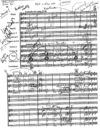
Iverson, (a six-year veteran of BPYO and already a powerful musical force), wrote:
By the way, I don’t think I’ll ever forget the way you played the 2nd movement of the Beethoven 5th on the piano on Saturday. It was so beautiful, I couldn’t help but think “yes, this is exactly how Beethoven would have wanted it to sound.” If I ever get the chance to conduct the piece I will always have that small moment in my ear.
Here it is: click here.
Assignment for the week:
THROW YOURSELF INTO LIFE LIKE A PEBBLE INTO A POND AND WATCH THE RIPPLES.
View all the Rehearsal Recaps in the BPYO during COVID Collection.
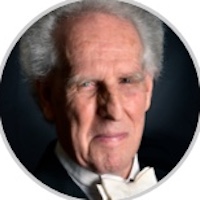 Benjamin Zander
Benjamin Zander